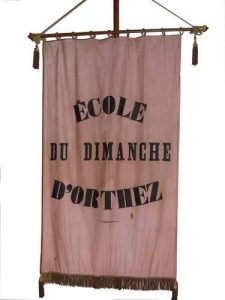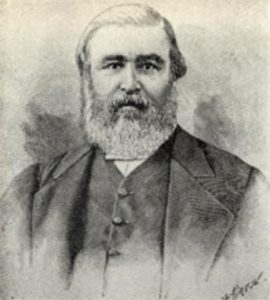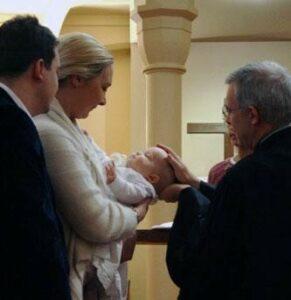The origins
The word catechism comes from the Greek ‘Katekein’ which means echoing or reverberating. It refers to oral teaching not of rites but articles of faith and hope. It is actually a response to the Word that keeps us alive, to keep life in tune with the Gospel. Catechisis involves not only catechists, the young people and their parents but also the whole community. A believer is called to keep learning and witnessing to his faith.
The notion of catechetics is a legacy from Christian antiquity, and appeared when Christianity was in times of adversity. The Reformation revived catechetics by simultaneously creating catechism in order to curb the religious waverings of the late Middle-Ages, and to anchor the believer in a confessing community.
Various catechetic models
- The biblical model is to make disciples : Jesus teaching in the synagogues, in the Temple in Jerusalem, in cities and towns, by the seaside ; he indiscriminately addressed disciples, Pharisees and crowds. The pastoral Epistles put the emphasis on scripture-based teaching.
- The classical model is to create a catechumenate : such organising had become necessary with the growing number of church members, their geographical spread and the increase in heresies, but also because of persecution by the State and hostility of the people.
The Edict of Milan in 313 made Christian religion official. The meaning of sacraments changed and they became sacred rituals allowing people to obtain salvation and become part of society. Religious education belonged to a branch of scholastic theology, which meant that the biblical and historical approach of the Fathers was replaced by a scholastic method founded on an abstract, logical approach in which truth-based beliefs overrule the preaching of the Good News and the conversion of hearts.
- The modern Reformed model is a structured catechism : the Reformation introduced catechism and related textbooks were published. It thus met a practical as well as a theological need, and also launched a literary genre which was to be an inter-confessional success. Each individual should be taught the fundamental elements of faith. Over the first few years of the Reformation more than thirty catechisms were published.
The various catechisms
In 1529, Luther wrote 2 catechisms and had them published : le Petit Catéchisme à l’usage des pasteurs et des prédicateurs peu instruits (Short Catechism to be used by pastors and little-educated preachers) for beginners and for domestic use ; and then le catéchisme allemand ou Grand Catéchisme (German Catechism or Long Catechism) for those in charge of religious education. Thanks to their structure (questions and answers) and their contents they became the template for a number of other catechisms in the 16th century beyond the boundaries of Protestantism.
In 1545, Calvin published le Catéchisme de Genève, fait en manière de dialogue, où le ministre interroge et l’enfant répond (Geneva Catechism, presented as a dialogue, in which the minister asks questions and the child answers them) soon replaced by the Catéchisme de Heidelberg (Heidelberg Catechism). The latter was written in 1563 by a team of theologians gathered by Frederic III, prince-elector of Palatinat, who had joined the Reformation.
The nature of these catechisms, sometimes doctrinal, was balanced by the existential message of a personal God who could be trusted. Nevertheless, these texts were difficult and often had to be learnt by-heart to be remembered. Indeed they contained nothing practical to help guide catechumens in their everyday life. Nevertheless, the texts left their mark on the Protestant mind-set.
Towards the end of the 17th century the strictness of the texts was questioned, and Ostervald, pastor of Neuchâtel in Switzerland, decided to write a catechism “afin de former le Coeur et le jugement des enfants” (“to mould the hearts and minds of children”). In 1702 Le catéchisme ou instruction dans la religion chrétienne (The catechism or education in the Christian faith) was published and met with considerable success, especially in its abridged version which was used until the end of the 19th century.
Sunday schools
The revival movement at the end of the 18th and beginning of the 19th centuries was aimed at making the whole world read the Bible. It was then that the first Sunday schools appeared, along with the first Bible Societies and Missionary Societies. The first Sunday school was created in Great Britain in 1781. In groups of 6 to 8 the children were taught to read, particularly the Bible. Groups met, under the leadership of an Anglican priest, at first not as part of churches, although they were later incorporated into them.
In France many Sunday Schools developed on the fringes of churches and schools. There were about 130 when the SED -Société des Ecoles du Dimanche- (Association of Sunday Schools) was founded by Jean-Paul Cook in 1852. He was a young evangelist trained in Switzerland and Great Britain who had published a booklet entitled L’histoire et l’organisation d’une Ecole du Dimanche (The History and Organising of a Sunday School ) in 1848, in which education and the curriculum were explained. In 1851 he published a jounal entitled Le Magasin des Ecoles du Dimanche (The Magazine for Sunday Schools ).
The SED (Association of Sunday schools) defined its aim : to spread evangelical truths through Sunday Schools. The SED supported the creation of such schools, encouraged their improvement but did not interfere with their leadership. Their scope was of a missionary nature. All Protestant churches were encouraged to join the movement. The training was exclusively Bible based. The pastors were asked to participate in the movement, provided they were accompanied by lay-people. In its early days the SED designed teaching material published by a Paris publishing house set up in 1857. In 1865 La Feuille du dimanche (The Sunday sheet) for the children was published every week and featured a biblical text, a story and sometimes an illustration ; in 1888 the journal des Ecoles du Dimanche (Journal of Sunday Schools took over from Les Leçons bibliques (Biblical Lessons) created in 1867 ; then the pictures, features, biblical scenes, bright colours and a calendar contributing to modernising its teaching method…
During the National Synod of the Reformed Churches in Le Havre in 1902, pastor Wilfred Monod questioned the teaching of Sunday Schools, and stressed the fact that all age ranges followed the same compulsory programme and that it did not prepare the children for church community life or public worship.
Catechising today
The difficulty with catechesis arises from its position sitting between teaching, communication and witnessing. While taking into account the fact that neither endless theological synthesis, nor definitive teaching actually exist, one should always be asking who catechesis is aimed at, i.e. children, teenagers, young adults… and how best to do it.
In 2002 the SED was disbanded and replaced by the Joint Committee for Edification and Training which suggested several approaches :
- An opening onto the world in the Bible to allow a personal interpretation of the texts and questioning of them.
- A source of information about the symbols of the Christian faith, the history of Christianity, and also how differently faith was expressed compared to the present day.
- A meeting with witnesses ; biblical characters but also catechists, members of the Church, or people playing a part in society…
- A chat space for everyone to debate openly and in confidence about beliefs and doubts, on one’s attitude towards the world and God. Meditation is based on biblical texts and testimonies.
A regional catechesis group considered the fundamentals of catechising in the modern world, and helped equip pastors and catechists for the job of communicating the faith.
In practice
Small groups of children met together for catechesis at the Temple. Depending on the parish they were taught by the pastor or by instructors either alone or in pairs. In some parishes the pastor was only present at the beginning to introduce the subject, or at the end for meditation. Programmes differed between parishes, but the topics remained the same. Thus, during the years one was taught about the bible, the whole gamut of biblical characters was dealt with. During catechism, which was variable in duration, a more topic-oriented approach to the Scriptures was suggested, along with a comparative study of the main religions, or the history of the Reformation. On the whole, the pastor was in charge of the last year of catechism leading the teenagers to Confirmation and their first Holy Communion. Each catechumen was individually interviewed by the pastor as part of the preparation.
To summarize, there are three steps in religious education :
- Bible-garden for 3 or 4 year-olds, held every other Sunday during worship.
- Bible school for 7 to 10/11 year-olds, held either during worship, or on a week-day every week or every other week.
- Catechism for 11 to 15 year-olds which can differ widely between parishes, e.g. an hour and a half every other week, one day per month…, depending on the geography of the parish.
- Post-catechism for 15 to 18 year-olds with group discussions, themed gatherings or parties to keep up links and friendships within the group.






